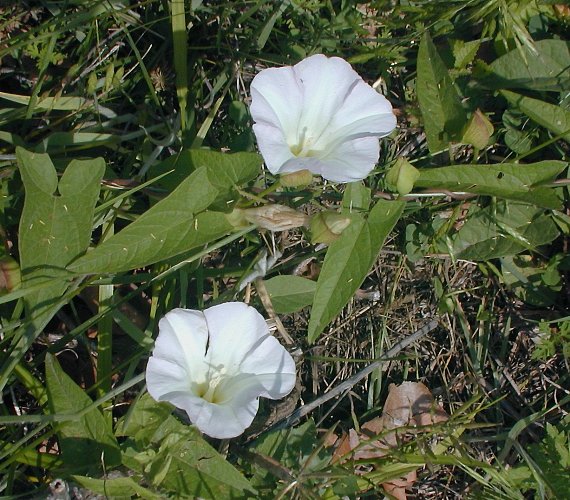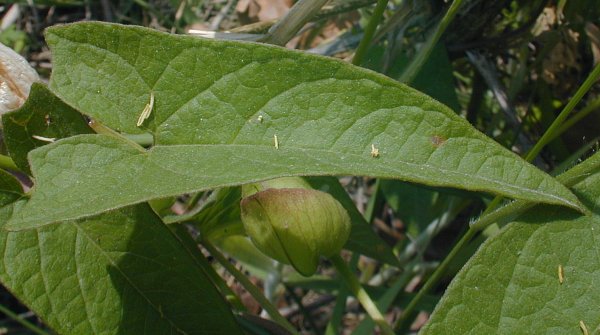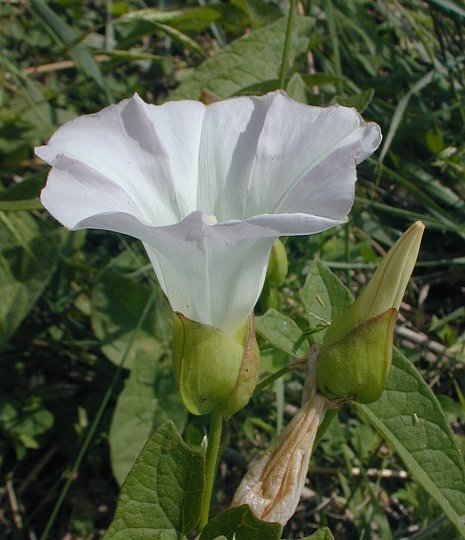Description: This is a perennial herbaceous vine up to 10' long that often climbs over other plants, shrubs, and fences. The twining stems are light green to red, glabrous to slightly hairy, and terete; alternate leaves are sparsely to moderately distributed along these stems. The leaves are about 2½-5" long and 1-2" across; they are sagittate-triangular or hastate-triangular in shape, while their margins are smooth and slightly ciliate. The basal lobes of these leaves are rather angular and squared-off in shape, although sometimes they are more rounded. The sinuses of the leaves are strongly indented between the basal lobes and either flattened or rounded. The upper leaf surface is medium green and glabrous (or nearly so), while the lower leaf surface is light green and glabrous to finely hairy. The slender petioles are about one-half as long as the leaves. The large buds produce flowers with funnelform corollas that are 2-3" across and similarly long; they are slightly 5-lobed. These corollas are usually white, although sometimes they are pale pink with spreading white stripes. However, deep within their throats the corollas are yellow.

At the base of each flower, there are 5 light green sepals that are largely hidden by a pair of large bracts. These bracts are light to medium green (often with reddish margins), broadly ovate in shape, keeled, and about ½-1½" long. Within the throat of each corolla, there is a white style with a pair of stigmata and 5 stamens (the latter adhere to the corolla). Usually the flowers are produced individually from the axils of the leaves, although there exists one subspecies of Hedge Bindweed (ssp. silvatica) that produces flowers in pairs from the axils of the leaves. The slender peduncles and/or pedicels of these flowers are shorter than the leaves. The flowers open during the morning and usually close at around noon, although they may remain open longer on cloudy days. The blooming period occurs intermittently during the summer for about 1-3 months. However, individual flowers last only a single day. Afterwards, the flowers are replaced by broadly ovoid seed capsules a little less than ½" (about 8-10 mm.) across. At maturity, these capsules split open to release their seeds (2-4 seeds per capsule). These seeds are dull brown to black, 3-angled (two flat sides & one rounded side), and rather irregular in shape; they are a little less than ¼" (about 4-5 mm.) long. The root system is fibrous and rhizomatous, and it may extend into the ground up to 10'. Hedge Bindweed spreads by clonal offshoots from its rhizomes or by reseeding itself.

Cultivation:
This is an adaptable vine, preferring full to partial sun and
moist to mesic conditions. It tolerates poor soil, often flourishing in
areas that are gravelly or sandy. Hedge Bindweed readily climbs a
trellis, fences, and neighboring plants, while in open areas it sprawls
haphazardly across the ground. The climbing ability is the result of
the stems twining tightly about slender objects. This vine can spread
aggressively and become a nuisance in some locations. It is known to
produce allelopathic chemicals that inhibit the growth of other plants.
Range & Habitat:
The native Hedge Bindweed is common in most areas of Illinois,
especially in the central and northern sections of the state (see Distribution
Map). This vine is considered a noxious weed in some
states, although it is not listed as such in Illinois. In addition to
its wide distribution in North America, Hedge Bindweed
is also native to Eurasia. It is likely that some populations of
this species within the state have been introduced from other areas of
North America or Eurasia.
Habitats include edges of moist to mesic prairies, railroad prairies,
thickets, woodland borders, open floodplain areas along lakes and
rivers, edges of cropland, abandoned fields, fence rows,
roadsides, areas along railroads, poorly maintained hedges,
and urban waste areas. Hedge Bindweed is more common in disturbed areas.

Faunal Associations: Long-tongued bees are the primary pollinators of the flowers, including bumblebees, little carpenter bees (Ceratina spp.), and such oligolectic bees as Melitoma taurea (Mallow Bee), Peponapis pruinosa pruinosa (Squash & Gourd Bee), and Cemolobus ipomoea (Morning Glory Bee). It is likely that day-flying Sphinx moths visit the flowers during the morning. These insects obtain primarily nectar from the flowers. Several species of tortoise beetles feed on the foliage of Hedge Bindweed and similar species in the Bindweed family, including Agroiconota bivittata (Striped Tortoise Beetle), Charidotella sexpunctata (Golden Tortoise Beetle), Chelymorpha cassidea (Argus Tortoise Beetle), Deloyala guttata (Mottled Tortoise Beetle), and Jonthonota nigripes (Black-legged Tortoise Beetle). Other insect feeders include Chaetocnema confinis (Sweet Potato Flea Beetle), Typophorus nigritus (Sweet Potato Leaf Beetle), larvae of Neolasioptera convolvuli (Bindweed Stem Gall Midge), larvae of Bedellia somnulentella (Morning Glory Leafminer Moth), and larvae of Emmelina monodactyla (Morning Glory Plume Moth). Mammalian herbivores tend to ignore this plant when other food sources are available as the foliage is toxic. To a limited extent, the Bobwhite Quail and Ring-Necked Pheasant eat the seeds.

Photographic
Location:
The photographs were taken along a railroad in Urbana, Illinois, and at
the Red Bison Railroad Prairie in Savoy, Illinois.
Comments:
Many varieties and subspecies of Hedge Bindweed have been described
that vary in
regards to such characteristics as the shape of the basal lobes of
their leaves, the relative sizes of their sepals and floral bracts, the
relative size of their corollas, and whether 1 or 2 flowers are
produced per leaf axil. These varieties and subspecies are not further
discussed here, although see Mohlenbrock (2002) for a dichotomous key
to those that occur in Illinois. The flowers of Hedge Bindweed are
large and showy when they are fully open. They are just as attractive
as many cultivated varieties of Ipomoea
purpurea
(Common Morning Glory). Hedge Bindweed can be readily distinguished
from this latter species by the shape of its leaves, which are
sagittate-triangular or hastate-triangular with angular to rounded
basal lobes. In contrast, the leaves of Common
Morning Glory and 2 native species, Ipomoea pandurata
(Wild Sweet Potato) and Ipomoea
lacunosa (Small White Morning Glory), are more cordate in
shape. Another common species,
Convolvulus arvensis
(Field Bindweed), differs by having smaller sagittate leaves with
narrow basal lobes, and its funnelform flowers are also smaller in size
(less than 1½" across).